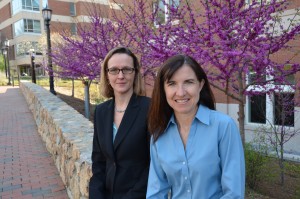Bridging Troubled Waters
May 5, 2016
Until the Flint, Mich., water crisis, some in the U.S. may have thought access to clean water was a concern only in developing countries. The situation in Flint shows how lack of transparency and shortsighted, uninformed decisions about the city’s water supply caused life-altering, negative impacts on the health of community residents. In Flint, children from poor families, many of them African-American, were affected disproportionately by exposure to lead in the water.
Gillings School of Global Public Health faculty members say that we face problems with unsafe drinking water in many places in the U.S., including here in North Carolina. Duke Energy’s 2014 coal ash spill into Virginia’s Dan River, for instance, sent between 50,000 and 80,000 tons of toxic coal ash more than 70 miles downstream into North Carolina, causing public health threats to humans and wildlife. (Read more at sph.unc.edu/superfund/coal-ash.)
Poor, rural and minority communities are more likely to have water that is substandard and not connected to municipal water systems. More than two million people in the U.S. depend upon private wells as the source of drinking water, and those wells are not regulated by state or federal law. Likewise, as many on our faculty, now and earlier, have stressed, even municipal water infrastructure systems in the U.S. are old and require serious examination and upgrades.
Rebecca Fry, PhD, associate professor of environmental sciences and engineering (ESE), has found the presence of arsenic, manganese, cadmium and lead in private wells across the state, in levels rivaling those in developing countries. Fry’s team has shown that high levels of the metals may have negative impacts upon the health of pregnant women and their infants, including risk for preeclampsia and birth defects.
“This is a big problem,” she says, and her lab and the N.C. Center for Environmental Risk Analysis (NC-CERA) are addressing it on multiple fronts. Through the NC-CERA, her team has developed websites and informational materials for consumers; they also are working directly with county health directors to raise awareness about the issue.
In collaboration with the UNC School of Medicine, Fry is working on changes to ensure that data captured by the electronic medical record system during prenatal visits includes information about women’s sources of drinking water. Such data could provide important insights about the effects of different levels of contaminants in water on human health.
Jackie MacDonald Gibson, PhD, also an associate professor in ESE, was funded by the Robert Wood Johnson Foundation to examine racial disparities related to water access and quality. She focused especially on the safety of well water and found high levels of microbial pathogens and human fecal waste in wells that were located in African-American communities at the edge of urban areas in the state.

Her team also found racial disparities related to which homes are given access to municipal water, and MacDonald Gibson aims to raise awareness about why some households are offered city water while others aren’t. Last fall, she presented study findings in a keynote address at a conference hosted by the N.C. Research Triangle Environmental Health Collaborative. The event brought together executives from state agencies and the Environmental Protection Agency to discuss solutions.
MacDonald Gibson notes that exclusion from municipal water is a vestige of the Jim Crow era, when African-American communities within urban areas were denied access to all municipal services, including water, sewer, street lighting and paved roads. Because these neighborhoods are surrounded by historically white communities within the city limits, she refers to them as “doughnut holes.”
MacDonald Gibson and other Gillings School students and faculty members have engaged in research, service and advocacy in one such local neighborhood – the Eubanks-Rogers Road community in Chapel Hill, where an adjacent landfill has caused health risks related to air and water pollution. Gillings School students who were members of Engineers Without Borders answered the call of neighborhood leaders in 2009 to assess potential hazards and have retained a working relationship with the community since then. At the time of their first involvement, nine of 11 wells in the community did not meet EPA water quality standards.
“Communities with higher population densities may be at higher risk of water contamination, but if they have lower incomes, they are less able to take action, such as installing home treatment systems, to reduce the risk,” MacDonald Gibson says.
–Elizabeth Witherspoon
.
MacDonald Gibson’s article about disparities in access to municipal services was published Aug. 13, 2015, in the American Journal of Public Health.
Read ‘Global health is local public health,’ Dr. Peggy Bentley’s article about the Rogers-Eubanks neighborhood, in the Sept./Oct. 2010 issue of the N.C. Medical Journal.

Public health and social justice advocate Crystallee Crain, PhD, presented the 2016 Minority Health Conference’s William T. Small Jr. Keynote Lecture on “Mending the Wounds of Incompetence: Justice at the Intersection of Academia and Activism.”
Hear her comments about Flint in the online video of the lecture.
 Philip C. Singer, PhD, professor emeritus of environmental sciences and engineering, serves on a committee appointed by the Michigan Department of Environmental Quality to provide guidance on long-term solutions to Flint’s water quality issues.
Philip C. Singer, PhD, professor emeritus of environmental sciences and engineering, serves on a committee appointed by the Michigan Department of Environmental Quality to provide guidance on long-term solutions to Flint’s water quality issues.
Read more at tinyurl.com/singer-in-flint.
.
Carolina Public Health is a publication of the University of North Carolina at Chapel Hill Gillings School of Global Public Health. To view previous issues, please visit sph.unc.edu/cph.

